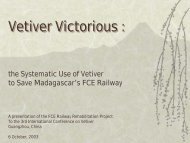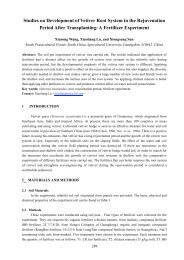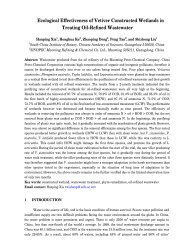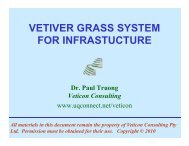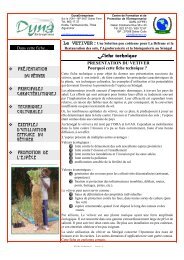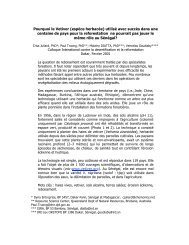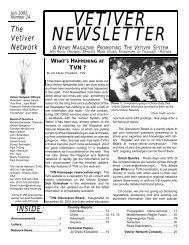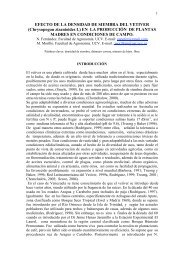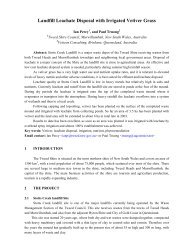BA05Ppt9 Gelita2.ppt [Read-Only]
BA05Ppt9 Gelita2.ppt [Read-Only]
BA05Ppt9 Gelita2.ppt [Read-Only]
Create successful ePaper yourself
Turn your PDF publications into a flip-book with our unique Google optimized e-Paper software.
CURRENT VETIVER SYSTEM<br />
RESEARCH, DEVELOPMENT<br />
AND APPLICATIONS AT<br />
GELITA APA, AUSTRALIA<br />
Cameron Smeal<br />
GELITA Australia, Beaudesert, Queensland, Australia<br />
Paul Truong<br />
Veticon Consulting, Brisbane, Queensland, Australia
Australia<br />
Beaudesert
Previous findings<br />
• Very high tolerance of vetiver to<br />
nitrogen/phosphorus<br />
• More than 8 t/ha N, 800kg/ha P<br />
• Extremely high nutrient uptake<br />
capacity<br />
• Very high biomass generation,<br />
approximately 130 t/ha<br />
• Younger shoots palatable to stock
Tolerance to extremely high<br />
levels of nutrients<br />
Shoot Dry Weight (g/pot)<br />
100<br />
80<br />
60<br />
40<br />
20<br />
0<br />
0 2000 4000 6000 8000 10000<br />
N Application (kg/ha/yr)<br />
Shoot Dry Weight (g/pot)<br />
100<br />
80<br />
60<br />
40<br />
20<br />
0<br />
0 200 400 600 800 1000<br />
P Application (kg/ha/yr)
N kg/ha/year<br />
1200<br />
1000<br />
800<br />
600<br />
400<br />
200<br />
0<br />
Vetiver Dryland<br />
1,140<br />
Rhodes Grass<br />
NITROGEN UPTAKE<br />
600<br />
Kikuyu Grass<br />
500<br />
Forage Sorghum<br />
360<br />
Plant Species<br />
Rye grass<br />
250<br />
Eucalyptus<br />
90
P kg/ha/year<br />
160<br />
140<br />
120<br />
100<br />
80<br />
60<br />
40<br />
20<br />
0<br />
Vetiver Dryland<br />
149<br />
PHOSPHORUS UPTAKE<br />
Rhodes Grass<br />
90 90<br />
Kikuyu Grass<br />
Forage Sorghum<br />
Plant Species<br />
70 70<br />
Rye grass<br />
Eucalyptus<br />
15
SOME VETIVER SYSTEM<br />
APPLICATIONS IN AUSTRALIA<br />
• Industrial effluent disposal<br />
• Domestic effluent disposal<br />
• Landfill leachate disposal<br />
• Wetland<br />
• Floating pontoons
Industrial effluent disposal at GELITA
Toilet<br />
Domestic Effluent disposal in Brisbane.<br />
Septic<br />
Effluent<br />
Sugarcane<br />
Banana<br />
Vetiver
Six months after planting this stand of 100 plants absorbs<br />
all the discharge from the toilet block
Landfill leachate disposal in NSW, Australia
Wetland to treat municipal sewage effluent
Hydroponic treatment of municipal sewage effluent
CURRENT VETIVER RESEARCH, DEVELOPMENT<br />
AND APPLICATIONS AT GELITA<br />
• Soil Based Reed Beds<br />
• Agrochemical Retention and Disposal<br />
• Evapo-transpiration of Vetiver Grass<br />
• Vetiver Essential Oil for Pest Control and<br />
Pharmaceutical Uses<br />
• Effects of Vetiver Grass on Some Soil Physical<br />
and Chemical Properties
SOIL BASED REED BED<br />
OBJECTIVES<br />
GELITA Australia initiated this field research to:<br />
• Demonstrate the suitability of vetiver grass for use in the<br />
SBRB system to treat nitrogen rich industrial effluent<br />
• Use the research findings in order to develop and<br />
establish a SBRB system that is capable of purifying<br />
GELITA’s wastewater to a satisfactory level<br />
• Develop a SBRB system using vetiver grass suitable for<br />
the treatment of high strength wastes both in Australia and<br />
world wide.
Soil Based Reed Beds<br />
The SBRB system has three simple components:<br />
• A shallow bed of soil , sand or gravel<br />
• A suitable wetland plant<br />
• Micro-organisms (fungi and bacteria)
Reed bed construction at GELITA, Australia<br />
40m<br />
4m
New planting on sand bed<br />
Sampling points
Soil Based Reed Beds with clay, sand and gravel beds at GELITA
AGROCHEMICAL RETENTION AND DISPOSAL<br />
OBJECTIVES<br />
• To demonstrate the benefits of vetiver grass filter strips on<br />
farms in reducing herbicide movement into the aquatic<br />
environment<br />
• To develop a simple system suitable for easy adoption by<br />
the farming community to improve water quality<br />
• To promote the adoption of the Vegetative Buffer Strip for<br />
Soil Erosion & Deposition model developed by Griffith<br />
University, Brisbane, Australia
Atrazine Capture and Retention Project<br />
Pond<br />
Vetiver
18 month old<br />
vetiver ready<br />
for treatment<br />
Atrazine<br />
Capture and<br />
Retention<br />
Project
Atrazine Capture and Retention Project ready for trial
Nine sets of sampling points, each at 3 depths: 20cm, 50cm and<br />
100cm
Boring for installation of monitors
Depth<br />
Seepage<br />
Collector<br />
Hand pump<br />
Collecting tube<br />
FullStop subsoil<br />
seepage monitor
A set of sampling point with 3 collectors at 20cm, 50cm and 100cm<br />
depth<br />
20cm<br />
100cm<br />
50cm
EVAPO-TRANSPIRATION OF VETIVER GRASS<br />
OBJECTIVES<br />
The principal objective is to determine accurately the<br />
transpiration rates<br />
The evapo-transpiration rate of vetiver reported in the literature<br />
varied from 3.8 mm/day in summer and 1.9 mm/day in winter under<br />
field conditions to 43 mm/day under effluent treatment conditions.<br />
These are up to 4-10 times greater than normal rates.<br />
If such extreme claims are incorrect, environmental damage could<br />
result from undersized effluent irrigation schemes.
Evapotranspiration
Plot Design for Transpiration Study (A. Vieritz)
Experimental Design<br />
Experimental Design<br />
• 12 bays of 3m _ 3m in area, 1.45 m deep and 4m apart,<br />
orientated perpendicular to the predominant wind direction.<br />
• 4 treatments _ 3 replicates<br />
Treatments<br />
1- Vetiver (Chrysopogon zizanioides)<br />
2- Kikuyu (Pennisetum clandestinum) a pasture grass<br />
3- Broad leaf Cumbungi (Typha orientalis) – a wetlands<br />
species endemic to the area<br />
4- Control (bare ground)
3m x 3m x 1.45m deep bay<br />
lined with heavy<br />
waterproof membrane
Sampling outlet<br />
Inlet
Twelve bays all set ready for planting
VETIVER ESSENTIAL OIL FOR PEST CONTROL<br />
AND PHARMACEUTICAL USES<br />
OBJECTIVES<br />
Literature search has indicated that vetiver essential oils (VO)<br />
have Antibacterial, Antifungal, Antioxidant and Antiinflammatory<br />
attributes.<br />
The aims of this project are to:<br />
• Determine the best extraction methods for _-vetivone and _vetivone<br />
and possibly other components as well.<br />
• Determine which Vetiver species has highest content of αvetivone<br />
and β-vetivone at which stage of growth.<br />
• Determine whether VO can be extracted from leaves<br />
• Whether heavy metals and other chemicals will affect the<br />
quality and quantity of VO<br />
• Whether VO contains heavy metals and other chemicals<br />
when used for phytoremediation
Extraction Methods<br />
Hydro distillation Steam distillation
Solvent extraction
EFFECTS OF VETIVER GRASS ON SOME<br />
SOIL PHYSICAL PROPERTIES<br />
OBJECTIVES<br />
Due to its extensive, deep and penetrating root system, it is<br />
expected that some soil physical and chemical parameters would<br />
be improved under vetiver cultivation<br />
The aims of this project are to:<br />
• Monitor the changes in hydraulic conductivity and soil bulk<br />
density<br />
• Monitor the changes in salinity and soil chemistry on various<br />
soils within the GELITA property<br />
• Provide soil-water parameters, which will determine<br />
appropriate irrigation management and monitoring programs
Determining saturated hydraulic conductivity<br />
Testing Guelph Permeameter Guelph Permeameter in the field
Variation in<br />
root growth by<br />
soil type<br />
700mm
Thank<br />
You


![BA05Ppt9 Gelita2.ppt [Read-Only]](https://img.yumpu.com/10873743/1/500x640/ba05ppt9-gelita2ppt-read-only.jpg)

